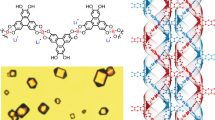Abstract
In this review, the development of low-molecular-weight gelators and polymer-based gelators is described. The driving forces for physical gelation are non-covalent bonds, such as hydrogen bonds, electrostatic interactions, van der Waals interactions and π–π interactions. When gelation occurs, the gelator molecules self-assemble into macromolecule-like aggregates through non-covalent intermolecular interactions. The close relationship between crystallization and gelation is discussed. Crystallization is a phenomenon in which crystals are separated from solution by the formation of a three-dimensional arrangement of solute through intermolecular interactions. Conversely, physical gelation is caused by the trapping of solvent in fibrous networks that are formed by gelator molecules through intermolecular interactions. Amino acid derivatives and cyclic dipeptides are introduced as typical gelators. To develop gelators that form semipermanent stable gels, a new concept termed ‘gelation-driving segments’ is proposed. Polymer-based gelators that can form semipermanent stable gels are synthesized by connecting gelation-driving segments to polymers or oligomers.
Similar content being viewed by others
Log in or create a free account to read this content
Gain free access to this article, as well as selected content from this journal and more on nature.com
or
References
Terech, P. & Weiss, R. G. Low molecular mass gelators of organic liquids and the properties of their gels. Chem. Rev. 97, 3133–3159 (1997).
van Esch, J. H. & Feringa, B. L. New functional materials based on self-assembling organogels: from serendipity towards design. Angew. Chem. Int. Ed. 39, 2263–2266 (2000).
Estroff, L. A. & Hamilton, A. D. Water gelation by small organic molecules. Chem. Rev. 104, 1201–1217 (2004).
Suzuki, M. & Hanabusa, K. L-Lysine-based low-molecular-weight gelators. Chem. Soc. Rev. 38, 967–975 (2009).
Suzuki, M. & Hanabusa, K. Polymer organogelators that make supramolecular organogels through physical cross-linking and self-assembly. Chem. Soc. Rev. 39, 455–463 (2010).
John, G., Shankar, B. V., Jadhav, S. R. & Vemula, P. K. Biorefinery: a design tool for molecular gelators. Langmuir 26, 17843–17851 (2010).
Svobodová, H., Noponen, V., Kolehmainen, E. & Sievänen, E. Recent advances in steroidal supramolecular gels. RSC Adv. 2, 4985–5007 (2012).
Tam, A. Y.-Y. & Yam, V. W.-W. Recent advances in metallogels. Chem. Soc. Rev. 42, 1540–1567 (2013).
Raeburn, J., Cardoso, A. Z. & Adams, D. J. The importance of the self-assembly process to control mechanical properties of low molecular weight hydrogels. Chem. Soc. Rev. 42, 5143–5156 (2013).
Yu, G., Yan, X., Han, C. & Huang, F. Characterization of supramolecular gels. Chem. Soc. Rev. 42, 6697–6722 (2013).
Segarra-Maset, M. D., Nebot, V. J., Miravet, J. F. & Escuder, B. Control of molecular gelation by chemical stimuli. Chem. Soc. Rev. 42, 7086–7098 (2013).
Tachibana, T., Mori, T. & Hori, K. Chiral mesophases of 12-hydroxyoctadecanoic acid in jelly and in the solid state. I. a new type of lyotropic mesophase in jelly with organic solvents. Bull. Chem. Soc. Jpn 53, 1714–1719 (1980).
Yamamoto, S. Sorbitol derivatives. III. Organogel formation by benzylidenesorbitol. J. Chem. Soc. Jpn. Ind. Chem. Soc. 46, 779–781 (1943) Chem. Abstr. 46, 7047i (1952).
Hanabusa, K., Hiratsuka, K. & Shirai, H. Easy preparation and useful character of organogel electrolytes based on low molecular weight gelator. Chem. Mater. 11, 649–655 (1999).
Hanabusa, K., Tange, J., Taguchi, Y., Koyama, T. & Shirai, H. Small molecular gelling agents to harden organic liquids. J. Chem. Soc. Chem. Commun. 390–392 (1993).
Hanabusa, K., Matsumoto, M., Kakehi, A. & Shirai, H. Low molecular weight gelators for organic fluids: gelation using a family of cyclo(dipeptide)s. J. Colloid Interface Sci. 224, 231–244 (2000).
Hanabusa, K., Fukui, H., Suzuki, M. & Shirai, H. Specialist gelator for ionic liquids. Langmuir 21, 10383–10390 (2005).
Hoshizawa, H., Minemura, Y., Yoshikawa, K., Suzuki, M. & Hanabusa, K. Thixotropic hydrogelators based on a cyclo(dipeptide) derivative. Langmuir 29, 14666–14673 (2013).
Okabe, S., Ando, K., Hanabusa, K. & Shibayama, M. Dynamic light scattering and small-angle neutron scattering studies on organogels formed with a gelator. J. Polym. Sci. B 42, 1841–1848 (2004).
Suzuki, M., Setoguchi, C., Shirai, H. & Hanabusa, K. Organogelation by novel polymer organogelators with L-lysine derivative: the formation of a three-dimensional network consisting of supramolecular polymer and conventional polymer. Chem. Eur. J. 13, 8193–8200 (2007).
Author information
Authors and Affiliations
Corresponding author
Rights and permissions
About this article
Cite this article
Hanabusa, K., Suzuki, M. Development of low-molecular-weight gelators and polymer-based gelators. Polym J 46, 776–782 (2014). https://doi.org/10.1038/pj.2014.64
Received:
Revised:
Accepted:
Published:
Issue date:
DOI: https://doi.org/10.1038/pj.2014.64
This article is cited by
-
Role of organogel chemistry on rheology and microstructure of molecular gels rationalized by Hansen solubility parameters
Colloid and Polymer Science (2023)
-
Supramolecular organogel of polyureas containing POSS units in the main chain: dependence on the POSS and comonomer structures
Polymer Journal (2022)
-
Study of oleogel as a frying medium for deep-fried chicken
Journal of Food Measurement and Characterization (2022)
-
Liquid-liquid phase separation and self-assembly of a lysine derivative Fmoc-L-lysine in water-DMSO mixtures
Polymer Journal (2021)
-
Intracellular self-assembly of supramolecular gelators to selectively kill cells of interest
Polymer Journal (2020)



